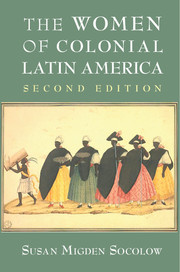Book contents
- Frontmatter
- Dedication
- Contents
- List of Figures
- Acknowledgments
- Introduction: Why Women?
- Chapter One Iberian Women in the Old World and the New
- Chapter Two Before Columbus: Women in Indigenous America and Africa
- Chapter Three Conquest and Colonization
- Chapter Four The Arrival of Iberian Women
- Chapter Five Women, Marriage, and Family
- Chapter Six Elite Women
- Chapter Seven The Brides of Christ and Other Religious Women
- Chapter Eight Women and Work
- Chapter Nine Women and Slavery
- Chapter Ten Women and Social Deviance
- Chapter Eleven Women and Enlightenment Reform
- Conclusion
- Documents
- Suggested Further Reading
- Index
- Plate section
- References
Chapter Three - Conquest and Colonization
Published online by Cambridge University Press: 05 February 2015
- Frontmatter
- Dedication
- Contents
- List of Figures
- Acknowledgments
- Introduction: Why Women?
- Chapter One Iberian Women in the Old World and the New
- Chapter Two Before Columbus: Women in Indigenous America and Africa
- Chapter Three Conquest and Colonization
- Chapter Four The Arrival of Iberian Women
- Chapter Five Women, Marriage, and Family
- Chapter Six Elite Women
- Chapter Seven The Brides of Christ and Other Religious Women
- Chapter Eight Women and Work
- Chapter Nine Women and Slavery
- Chapter Ten Women and Social Deviance
- Chapter Eleven Women and Enlightenment Reform
- Conclusion
- Documents
- Suggested Further Reading
- Index
- Plate section
- References
Summary
a Chinese wide shawl
another wide shawl, from the Quixos region, embroidered
a woolen wrap-around skirt and a woolen wide shawl
a large Chinese porcelain
two large stickpins with their bells
one small chain with two other stickpins of marked silver
one woven belt or girdle of purple silk, in the Roman style, with an ornamental border
a scarlet satin wide shawl with its silver brooch [?]
a new wide shawl of light silk or linen, with Castilian needlework
a wide shawl of green Castilian damask with golden edging
a choker of pearls and purple beads
some filigreed earrings with small pearl pendants
some earrings with three pendants edged with pearls
a choker of pearls and blue and red beads
more chokers of baroque pearls, silver, and bells
another choker of pearls and little golden bells and coral ...
two bracelets of coral and pearls.
The early years of European discovery and conquest of America was a period of violence, dramatic social change, and profound transformation in the lives of indigenous peoples. The Indian world was conquered, dismantled, and restructured according to the conqueror’s vision. Moreover, the arrival of Europeans and European pathogens combined with the violence of conquest to produce a demographic disaster of massive proportions. Throughout America, Indian peoples suffered a dramatic demographic decline. In parts of Latin America approximately 90 percent of the Indian population disappeared. Indian women probably experienced lower mortality than men, who were actively engaged in warfare.
The conquest probably had a more varied effect on Indian women than any other single group. But not all Indian women were equally affected by the conquest. The aftermath of conquest severed the lives of some women and reduced others to slavery; still others managed to integrate themselves into European society, in many cases more successfully than did Indian men. Thus, the conquest could be a traumatic experience or a new opportunity. In addition, the effects of conquest varied over time, with those who witnessed the destruction of their world and the imposition of European cultural, religious, and social values being far more affected than succeeding generations, who were born into a world already changed.
- Type
- Chapter
- Information
- The Women of Colonial Latin America , pp. 34 - 55Publisher: Cambridge University PressPrint publication year: 2015



